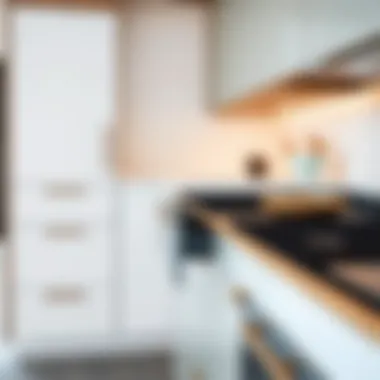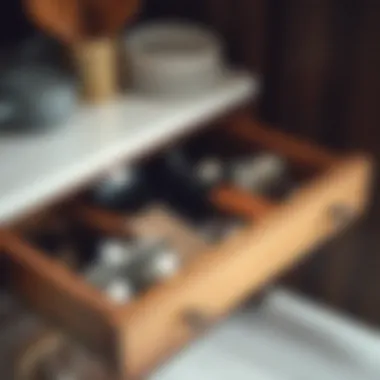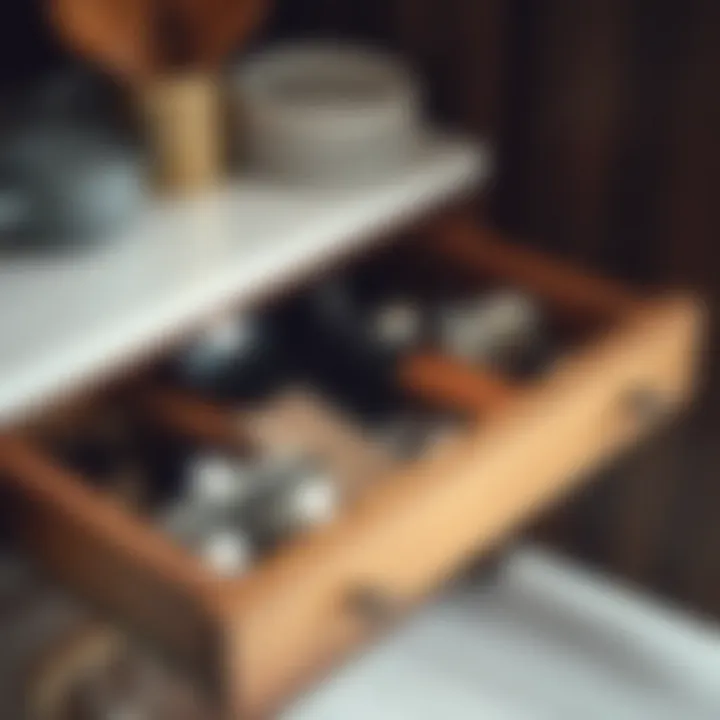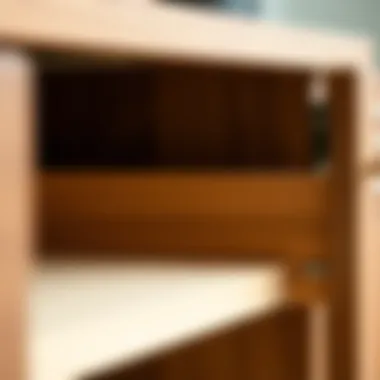Inside Cabinet Drawers: Design and Functionality Insights


Intro
Home design often focuses on grand features—walls, furniture, lighting—but there's a hidden aspect that deserves attention: the humble cabinet drawer. These spaces, tucked within cabinets, are crammed with potential often overlooked in design conversations. A well-structured drawer can transform chaos into order, ultimately enhancing our living spaces in ways that are both practical and aesthetically pleasing.
This article takes a closer look at inside cabinet drawers. It seeks not only to explore their functionality and design, but also to appreciate the significance of thoughtful organization. By breaking down styles, materials, and mechanisms, we’ll unveil how these elements play a crucial role in maximizing utility and enhancing beauty in various settings.
Additionally, we'll touch on how storage optimization techniques can bring about a revolution in our everyday interactions with our belongings. With communication being the cornerstone in elevating spaces, understanding the trends that influence drawer design will lay a strong foundation for anyone looking to improve their home environment.
So, let’s roll up our sleeves and delve right into the world of cabinet drawers, where design sophistication meets the intricacies of human organization.
Furniture Design Trends
Current Trends in Furniture Design
The furniture design landscape is in constant flux, influenced by changing lifestyles and emerging technologies. One evident trend is the rise of sustainable materials. Homeowners and designers alike are now gravitating towards eco-friendly options in drawer construction. Think bamboo or reclaimed wood that not only offers sturdiness but also an earthy aesthetic that feels right at home in any cozy kitchen or modern living room.
Another notable development is the growing popularity of modular drawer systems. These systems allow for a customizable approach to storage. Instead of a one-size-fits-all model, homeowners can create a configuration that suits their specific needs, blending functionality with artistic flair. Not only do these systems adapt to individual tastes, but they also offer flexibility which is especially handy in smaller spaces.
Influential Designers to Follow
If you’re looking to keep your finger on the pulse of drawer design, consider following a few modern designers who are making waves in the industry:
- Michele De Lucchi – Known for his forward-thinking designs, he integrates artistic elements with practical applications.
- Patricia Urquiola – Her work explores the relationship between space and furnishings with a focus on comfort and innovation.
- Herman Miller – This brand combines cutting-edge technology with timeless design, offering products that stand the test of time.
Staying updated with these individuals can provide insights on what’s next in the realm of furniture design. Their philosophies and creations can serve as a goldmine of inspiration.
Practical Tips for Furniture Selection
Choosing the Right Materials
When selecting materials for cabinet drawers, it’s critical to consider not just the aesthetic but also functionality. Here’s a shortlist of materials that have proven their worth:
- Plywood – Offers durability, lightweight properties, and is often less expensive than solid wood.
- Medium Density Fiberboard (MDF) – This material is versatile and can be finished in various ways, providing a sleek look.
- Metal – For a modern twist, metal drawers can withstand heavy use and integrate well into contemporary designs.
Choosing the right material involves balancing quality and purpose. Ask yourself what you’d like to achieve and choose accordingly.
Maximizing Space with Smart Furniture Choices
Saving space without sacrificing style is possible when it comes to drawer design. Here are some clever approaches:
- Slim Drawers: Ideal for tight spaces, offering places for utensils or miscellaneous items without dominating the room.
- Pull-Out Shelves: These allow for easy access to items at the back of a drawer, ensuring that nothing gets forgotten in the deep.
- Dividers and Organizers: Implement dividers within drawers to segregate items, which keeps everything orderly and easy to find.
Employing these tips can dramatically improve both the functionality and organization of cabinet drawers, allowing homeowners to maintain a clutter-free environment that looks as good as it functions.
"A well-designed drawer is a reflection of its owner's lifestyle—function, style, and organization seamlessly blended together."
Understanding Cabinet Drawers
In this exploration of cabinet drawers, it's vital to grasp their significance in interior design and functionality. Cabinet drawers serve more than just a purpose of storage; they are key in optimizing spaces, enhancing organization, and adding to the aesthetics of any cabinet system.
The design and layout of these drawers reflect the homeowner's style while considering practicality. They cater to various needs, whether it’s a kitchen looking for efficient utensil space, a bathroom seeking optimal storage for toiletries, or a living room in need of neatly tucked away games and gadgets. This understanding transcends mere construction, allowing designers and homeowners alike to appreciate the balance between form and function.
Moreover, opting for customized cabinet drawers can yield a tailored experience, fitting precisely into a unique home’s layout. With the right designs, drawers can help in decluttering spaces, making them not just livable but enjoyable. As we delve deeper into the historical evolution, functionality, and design aspects, recognizing the multifaceted role of cabinet drawers will allow for more informed decisions in their selection and usage.
Historical Evolution of Cabinet Drawers
Cabinet drawers have not always been the polished systems we recognize today. Their evolution started centuries ago, illustrating a blend between artistry and practicality in furniture design. Initially, drawers were mere boxes, often constructed from primitive materials, serving solely the purpose of storage.
Over time, as the art of woodworking flourished, the design of drawers became more refined. The introduction of dovetail joints in the 16th century marked a significant advancement, enhancing durability and allowing for more intricate designs. By the Industrial Revolution, the ability to mass-produce drawers paved the way for their widespread adoption in homes, changing the landscape of storage solutions.
Purpose and Functionality
Maximizing Storage Space
A crucial element of cabinet drawers is their ability to maximize storage space. In a world where homes are getting smaller, every square inch matters. Well-designed drawers can fit into corners, under counters, or even in spaces that seem too tight for conventional shelving. This attribute not only offers practicality but also contributes to an uncluttered look within the home.
The versatility of cabinets drawers lies in their different sizes and configurations, allowing them to store various items efficiently. For example, shallow drawers are perfect for flat objects or utensils, while deeper ones can accommodate bulkier items. This practical choice of maximizing available space lends homeowners a unique opportunity to organize their belongings in a way that aligns with their lifestyle.


One standout feature is the ability to customize drawer depths based on user preferences. While this can easily seem advantageous, it might require careful measuring and planning to prevent any miscalculations that could lead to wasted space or inconvenience.
Facilitating Organization
Another key role of cabinet drawers is their capability in facilitating organization. A thoughtfully designed drawer can transform chaos into order. Various contemporary organizational tools, such as drawer dividers and sectioned insert trays, enhance this functionality further. They enable homeowners to categorize items effectively, leading to quicker and easier access to essentials during daily tasks.
The organization provided by cabinet drawers offers a strategic advantage. It saves time and ensures that items are kept in designated areas rather than scattered across a countertop or shelf. Moreover, well-organized drawers give one's home a polished look, reflecting a sense of care and attention to detail.
It’s important to note, however, that maintaining such organization requires ongoing effort. Regularly assessing what's in the drawers and managing clutter can become a necessity. But with the right systems in place, like seasonal assessments, the task becomes far less daunting.
Design Considerations
When exploring cabinet drawers, the design aspect plays a pivotal role. For starters, the design not only contributes to aesthetic value but also determines the overall functionality of the cabinets. Well-planned designs can optimize storage and enhance the ease of access, making a world of difference in daily use. Considerations in this space involve everything from size and shape to the selection of materials, styles, and mechanisms that dictate how drawers operate and serve the purpose they are intended for.
The goal here is to create a coherent visual and functional experience. This means thinking beyond mere appearance; it’s about how pieces work together to provide efficiency and organize life. The right design can speak volumes about the personality of a space and reflect the homeowner’s values and preferences.
Styles of Cabinet Drawers
Traditional vs. Modern
A defining feature of traditional cabinet drawers is their craftsmanship and attention to detail. Intricately carved details, ornate handles, and rich woods characterize this style. Traditional designs typically evoke a sense of comfort and nostalgia, often anchoring a room's overall feel. However, they can sometimes require more maintenance due to the intricate design elements.
On the other hand, modern cabinet drawers embrace minimalism and functionality. They feature clean lines, simple forms, and a focus on practicality. These designs prioritize sleek silhouettes over ornamental flourishes, making them a popular choice for contemporary spaces where space efficiency and straightforward organization are prized. While modern designs offer a refreshing simplicity, they might lack the warmth traditionally cherished by many.
Minimalist Design Principles
Minimalist design principles in cabinet drawers emphasize function over form. The idea is to strip away all unnecessary elements, resulting in a cleaner space that feels more expansive. A key characteristic of minimalism is the use of neutral colors and materials, leading to a calm environment. This approach not only fosters serenity but also allows for simple organizing solutions.
However, a caveat of minimalist designs can be their perceived absence of personality. Some may find these spaces too stark or clinical if not executed thoughtfully. Nevertheless, the advantages lie in ease of maintenance and a highly adaptable style that accommodates various decor themes.
Material Selection
Wood Varieties
Wood varieties for cabinet drawers present a myriad of options, each with distinct characteristics shaping how they contribute to the overall design. For example, oak is well-regarded for its durability and appealing grain, offering a robust choice for heavy-use areas. Maple, with its subtle coloring, can provide a modern touch alongside resilience. Certain woods also feature natural oils that help resist moisture, minimizing wear over time.
However, using solid wood can come at a higher cost, and the need for regular upkeep can't be ignored. With time, certain woods can warp or split due to environmental factors. Hence, weighing aesthetic appeal against practical maintenance is essential when considering wood varieties.
Metals and Composites
Utilizing metals and composites in cabinet drawer construction brings a contemporary flair along with robust functionality. Metals, such as stainless steel or aluminum, can impart a sleek and industrial look. They are not only durable but also resistant to a variety of damages and require minimal maintenance, making them ideal for high-traffic areas.
On the flip side, composites, made from engineered materials, can provide both strength and versatility. They can be molded into various shapes and are often more cost-effective than solid woods. While composites offer up more design possibilities, their longevity may not match that of solid materials, and some options might off-gas chemicals if not produced under strict quality controls.
Mechanisms and Hardware
When it comes to the functionality and design of cabinet drawers, the choice of mechanisms and hardware plays a pivotal role. These elements not only determine how drawes operate but also influence their longevity and ease of use. Understanding different slides and hardware options can make all the difference between a drawer that glides smoothly and one that constantly jams or feels flimsy.
Types of Drawer Slides
Side-Mounted Slides
One of the most common types of drawer slides are side-mounted slides. This mechanism consists of two metal rails attached to the sides of the drawer, allowing it to move in and out of the cabinet frame. A key characteristic of side-mounted slides is their simplicity in installation and adjustment. Moreover, they can be more affordable compared to other options, making them a popular choice for budget-conscious projects.
However, these slides do have their caveats. While they function well for lightweight drawers, they might not support heavier loads without causing wear and tear over time. Another drawback is that they sometimes decrease the usable space within the drawer due to their mounted placement. In terms of benefits, side-mounted slides are user-friendly and work effectively when paired with lighter items, making them a favorable option if you prioritize ease of installation.
Undermount Slides
Beneath the surface lies a more refined solution: undermount slides. Installed below the drawer, these slides are generally considered a higher-end option. The main selling point of undermount slides is their clean appearance since they are hidden from view when the drawer is closed. Furthermore, they provide a smoother gliding experience, making them a preferred choice in modern cabinetry design. Undermount slides typically support more weight, allowing for a sturdier and more durable drawer.
However, they come with some limitations. Installation can be tricky and might require professional help, making them less ideal for DIY enthusiasts. Additionally, if the hardware malfunctions, repairs can be less straightforward due to their hidden nature. Still, for those who value aesthetics and functionality, undermount slides represent a sound investment in quality and design.
Handles and Pulls
Selecting the Right Hardware
Choosing appropriate handles and pulls is just as crucial as selecting drawer slides. The right hardware not only serves a practical function but also enhances the overall aesthetic of the cabinetry. A significant aspect of this selection process lies in understanding the balance between form and function. For example, choosing a handle with an ergonomic design allows for comfortable access while providing a chic finish. Stylish and robust hardware choices can elevate a simple drawer into a statement piece within a room.
On the downside, selecting hardware can become overwhelming, given the abundant variety available in the market. Factors such as size, shape, and material all come into play. It's vital to ensure that the selected hardware complements the overall design style of the kitchen or room in focus. In essence, selecting the right hardware fits both your functional needs and your design vision.


Integration with Overall Design
Integrating handles and pulls with the drawer's overall design is key to creating a cohesive look. The cohesion this integration achieves can profoundly affect the visual appeal of cabinets. Selecting hardware that matches the finish of other appliances or fixtures can help create an inviting space while maintaining continuity.
However, this process isn’t just about matching colors. Consideration for the overall scale and design of the kitchen or room is paramount. If handles are too prominent, they can overpower the cabinetry style. Conversely, if they’re too subtle, they may get lost in the design. Finding that sweet spot ensures that handles contribute to the space instead of clashing with it, ensuring a harmonious blend that speaks volumes about design wisdom.
"Choosing the right mechanisms and hardware goes beyond aesthetics; it’s about creating functionality that lasts."
For further reading on mechanisms and hardware in cabinetry, you may find more information at Wikipedia and Britannica.
Whether you're a homeowner looking to upgrade or an interior designer crafting unique living spaces, understanding the various mechanisms and hardware options can lead to enhanced drawer functionality and a more compelling design.
Organizing Inside Cabinet Drawers
Organizing inside cabinet drawers is more than just a tidy solution; it’s a game changer for maximizing functionality in any space. When drawers are in disarray, even the simplest tasks can turn into frustrating scavenger hunts. Therefore, the importance of a structured drawer organization cannot be overstated. By focusing on effective storage solutions and techniques for maintaining order, homeowners and designers can create spaces that are not only functional but also aesthetically pleasing.
The art of organizing translates into efficient accessibility and promotes an ease of use that can enhance daily life.
Effective Storage Solutions
Dividers and Organizers
One of the standout features of dividers and organizers is their ability to segment space within a drawer. This specific aspect helps to keep items from shifting around, resulting in a neat appearance. They're not just beneficial but often a popular choice for anyone looking for efficient cabinet drawer organization. A unique feature that sets dividers apart is their adaptability. Whether you have flatware, art supplies, or tools, dividers can be customized to fit various drawer types and sizes.
The advantages of using dividers include ease of access and visual clarity. It saves you from rummaging through a pile of items, making everyday tasks feel like watching a well-rehearsed ballet. The only disadvantage could be the cost involved with high-quality materials, but the long-term benefits often outweigh this.
Utilizing Vertical Space
Utilizing vertical space offers a key characteristic of maximizing every inch within a drawer. By stacking instead of spreading, you gain not only room but also a smart way to keep items visible and accessible. In your quest for drawer organization, this can be a game-changing approach.
The distinctive feature of vertical storage is the capability to store more without necessarily increasing the drawer's footprint. Ramps, tiered shelves, and upright dividers aid in this organization. While the convenience is evident, one downside may be the time it takes to initially set up this system. However, once established, it can lead to greater efficiency in the long run.
Techniques for Maintaining Order
Regular Clutter Assessment
Conducting a regular clutter assessment plays a crucial role in ensuring your drawers don’t fall back into chaos. This practice not only highlights what you truly need but also helps identify items that may have long outlived their usefulness. As a strategy, it’s both simple and popular among organized households.
What makes this technique effective is the fresh perspective it brings every few months. With drawers needing maintenance like anything else, the unique aspect here is that it forces a habit of continuous evaluation. In terms of advantages, this routine can lead to a sense of relief and improved function, while the downside is the potential for time commitment.
Seasonal Organization Tips
Seasonal organization tips can be an effective way to refresh and reset your drawer systems throughout the year. By aligning your organization strategy with seasonal activities—like switching out winter gear for summer items—you promote a dynamic and adaptable storage solution. This approach can help home dwellers maintain an organized space throughout various phases of life.
One key characteristic is the focus on relevancy; the items in your drawers only reflect the current season's needs. This can make life simpler during transitions, and enhances overall functionality. However, the potential downside may include consistently needing to re-evaluate, as drawers that are meant to adapt can become ignored if not attended to.
In summary, organizing inside cabinet drawers involves a thoughtful mix of effective storage solutions and maintenance strategies. This not only enhances usability but also elevates the living space as a whole, presenting an opportunity for transformation in both functionality and efficiency.
Trends in Drawer Design
In today's interior design landscape, drawer design has transcended mere functionality to become an essential aspect of a home’s aesthetics and utility. Understanding current trends provides valuable insights not just for those designing new spaces, but also for homeowners looking to refresh their existing cabinetry. This section delves into how modern innovations and eco-conscious choices are shaping the future of cabinet drawers.
Integration of Technology
Smart Drawer Systems
Smart drawer systems are the new wave in the cabinet design world, and their presence marks a paradigm shift in how we interact with our furniture. One prominent characteristic of these systems is their ability to integrate technology for enhanced convenience. Imagine a drawer that opens with a simple touch or even through motion sensors—these features offer both accessibility and a glimpse into the future of home automation.
The appealing aspects of smart drawers extend to their potential for organization; built-in mechanisms can remind users when items must be replaced or suggest optimal placements for kitchen utensils. However, this integration brings certain considerations. While the convenience is undeniable, the dependency on technology can raise concerns about maintenance and potential malfunctions. Evaluating their longevity and repairability is crucial before making the leap into smart technology.
Lighting Enhancements
Incorporating lighting enhancements in drawer design not only elevates the aesthetic appeal but serves practical purposes as well. One key attribute of these lighting designs is their ability to illuminate the contents of the drawer, making it easier to find items quickly. For instance, LED strips or motion-activated lights can create a sense of luxury while promoting functionality.
These enhancements can make a stark difference in dark spaces, particularly in kitchen and office drawers where organization can prevent clutter. On the flip side, this illumination often requires power sources that may complicate installation. Despite the potential drawbacks, the benefits of improved visibility and user experience make lighting enhancements a popular choice.
Sustainable Practices
Eco-Friendly Materials


With growing awareness of environmental issues, the selection of eco-friendly materials is a prominent trend in drawer design. The key feature here is that these materials offer sustainability without sacrificing durability. Biodegradable options, like bamboo and reclaimed wood, not only reduce the carbon footprint but also lend a unique beauty to furniture pieces.
Choosing eco-friendly materials also resonates with consumers looking for products that align with their values, making it a favorable choice in the current market. However, durability can sometimes be a concern. While many eco-friendly options are robust, the performance differs across products. It's essential to strike a balance between sustainability and longevity.
Designing for Longevity
Designing for longevity emphasizes the importance of creating drawers that withstand the test of time. Strong joints, quality materials, and thoughtful craftsmanship distinguish these designs from others that may favor aesthetics over resilience. This approach highlights a key characteristic: drawers built to last can save money in the long run while enhancing the overall value of the cabinetry.
One unique feature of this approach is the minimalistic design, eliminating unnecessary components that could wear down or fail over time. Yet, such designs must balance simplicity with style so as not to exclude particular visual appeal. In any case, investing in long-lasting designs can turn out to be both economically wise and environmentally friendly.
"Trends in drawer design are not just about what looks good; they speak volumes about a homeowner's values and commitment to sustainability and functionality."
As demonstrated, trends in drawer design today blend functionality with modern aesthetics and sustainable practices, aiming to provide practical yet stylish solutions that resonate with the evolving needs of homeowners.
Choosing the Right Cabinet Drawers
Selecting the appropriate cabinet drawers is paramount in designing a user-friendly and aesthetically pleasing space. Every drawer serves a function, whether for storing kitchen utensils, personal items, or documents. The right choice can make these spaces not just utilitarian but also stylish.
Assessing Needs and Space
Evaluating Cabinet Space
To get started right, one must understand how much room is available for cabinets and their drawers. Evaluating cabinet space is not merely about measurements—it's about visualizing how this space will integrate with the rest of the home. When you know your available dimensions, you can choose drawers that fit well without overwhelming the overall aesthetic.
A key characteristic of evaluating cabinet space is simplicity. It’s about taking careful measurements, considering the height, width, and depth to avoid those embarrassing moments when a drawer doesn't fit. Choosing the right size drawer can prevent clutter and ensure that every square inch is utilized effectively.
The unique feature of this evaluation process is that it allows for a tailored approach, adapting to specific needs. For instance, shallow drawers work well for spices in the kitchen, while deeper ones are better suited for pots and pans. However, if underestimated, this can lead to wasted space or improperly fitting furniture, which gets you nowhere.
Identifying Required Functions
Next up is identifying required functions—what you need these drawers to actually do. Different households have distinct demands. Some may require a drawer to hold an array of craft supplies, while others might need one for office equipment or kitchen ware. Recognizing and categorizing these needs leads to an efficient setup. This part of the process is critical as it shapes the effectiveness of each drawer.
The key characteristic here is versatility. Drawers that can be adjusted or repurposed can greatly enhance utility, adapting to changing household needs over time. Consider adding labeled dividers or functional inserts for a customized fit; it can help keep everything organized effortlessly.
However, one must also be cautious. Opting for drawers that promise various functions which are poorly built may lead to frequent repairs or replacements, cutting into long-term value.
Budget Considerations
Setting a budget doesn’t mean you have to skimp on quality. In fact, finding quality within a budget allows you to focus on both style and functionality without breaking the bank.
Finding Quality within Budget
This entails researching brands, reading reviews, and visiting showrooms. By exploring diverse options, you can pinpoint pieces that suit your aesthetic desires and price range. A key characteristic of finding quality within budget is the balance of initial investment against longevity. Quality drawer materials, like solid wood or well-crafted composites, may have higher upfront costs but deliver more durability and style over time.
A notable unique feature here is the potential for custom work. Local craftsmen or companies may offer attractive solutions tailored to your specific situation. However, beware of the temptation to choose cheaper, mass-produced items that often lack durability.
Long-Term Value Assessment
Finally, understanding long-term value assessment comes into play. This is not merely about how much an item costs at the time of purchase but how it performs over its lifetime. Factors like wear, ease of maintenance, and design trends are all worth considering.
The key characteristic of this assessment process is foresight—having an understanding of how your choices will serve you in years to come. Opting for drawers that are easily repaired or updated can be beneficial; for instance, a removable face frame might allow for an easy change of style without replacing the entire unit.
The significant advantage of conducting a long-term value assessment lies in making not just an investment but a strategic decision that aligns with your future needs and aesthetics. Avoid the mistake of viewing drawer choices in isolation; they are a part of a broader furniture ecosystem, influencing the whole space.
Closure
A well-thought-out drawer system holds immense value in the realm of interior design and functionality. This article shines a light on the significant benefits that derive from properly designed cabinet drawers. The conclusion wraps up the intricate interplay between functionality and aesthetics.
The Lasting Impact of Well-Designed Drawers
Cabinet drawers can be perceived as mere storage spaces, left to accumulate clutter and chaos. Yet, when designed thoughtfully, they become essential tools for enhancing home organization and elevating visual appeal. A drawer thoughtfully crafted can transform the mundane task of storing items into an experience of ease and efficiency.
Consider how the right design not only accommodates various items but does so in style.
"Good design adds value to our lives, affecting how we interact with our space daily."
The importance of functionality cannot be overstated. Efficiently designed drawers help maximize storage potential—after all, what's the use of having furniture if it doesn’t serve its purpose adequately? Integrating dividers or specialized organizers can optimize how items are stored, allowing for better access and visibility.
For homeowners and designers alike, understanding the mechanics of drawer design can yield remarkable improvements in space utilization. With the ongoing integration of smart technologies, users can now enjoy convenience right at their fingertips.
Additionally, sustainable practices in materials lend a hand in enhancing the longevity and environmental responsibility of drawer designs. Selecting eco-friendly materials not only benefits the planet but also adds a unique charm to the furniture, setting a distinctive tone that resonates with conscientious buyers and their aspirations.
Crafting drawers that serve multiple purposes, combined with a keen eye for design, creates an environment that embodies both style and practicality.
For further insights into effective design principles and modern trends, consider visiting Wikipedia or Britannica.
Stay informed and inspired as you navigate the world of interior design, making well-informed decisions that resonate with both functionality and aesthetics.



